新版人教版九年级英语Unit13全单元公开课教案共16页
- 格式:doc
- 大小:186.00 KB
- 文档页数:16
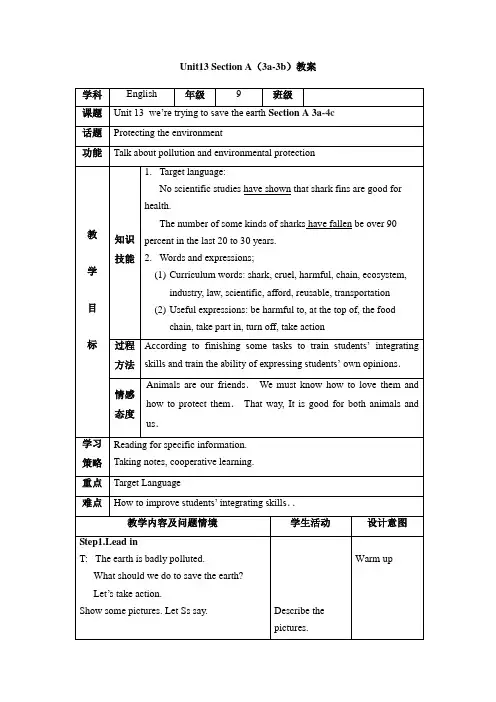
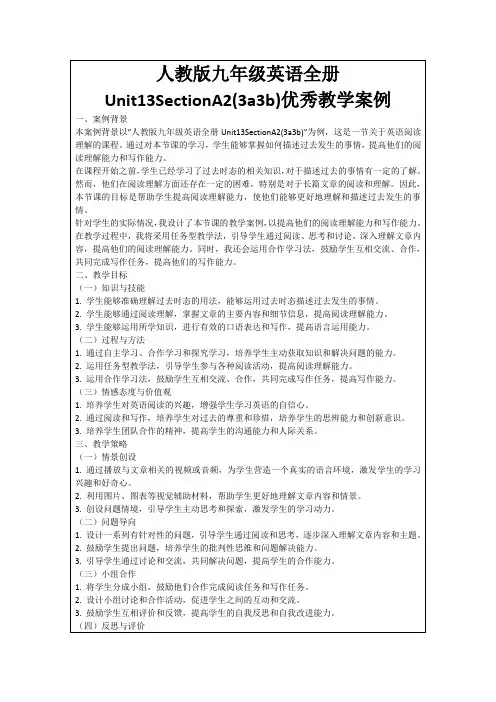
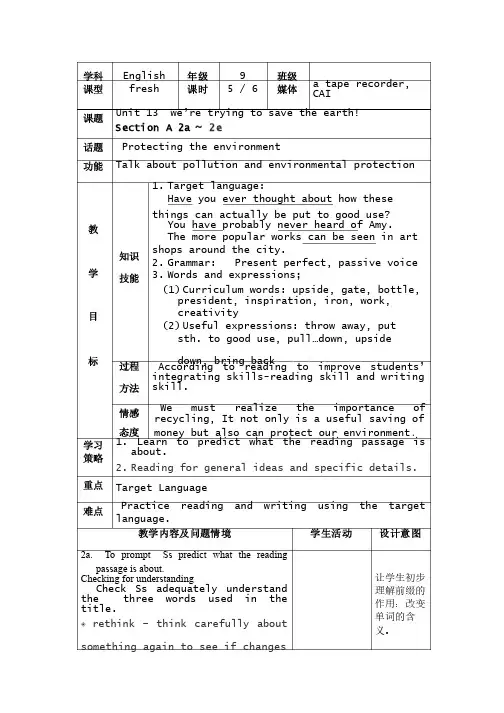
学科 English 年级9 班级课型 fresh 课时 5 / 6媒体 a tape recorder,CAI课题Unit 13 we Unit 13 we’’re trying to save the earth! Section A 2a ~ 2e话题 Protecting the environment功能 Talk about pollution and environmental protection教 学 目 标知识技能 1. Target language:Have you ever thought about how thesethings can actually be put to good use?You have probably never heard of Amy.The more popular works can be seen in art shops around the city.2. Grammar: Present perfect, passive voice3. Words and expressions; (1) Curriculum words: upside, gate, bottle,president, inspiration, iron, work, creativity (2) Useful expressions: throw away, putsth. to good use, pull sth. to good use, pull……down, upside down, bring back X k B 1 . c o m 过程 方法According to reading to improve students’ integrating skills-reading skill and writingskill.情感 态度 We must realize the importance ofrecycling, It not only is a useful saving of money but also can protect our environment . 学习策略1. Learn to predict what the reading passage isabout. 2. Reading for general ideas and specific details.重点 Target Language 难点Practice reading and writing using the target language.教学内容及问题情境学生活动设计意图 2a. To prompt Ss predict what the reading passage is about.Checking for understandingCheck Ss adequately understand the three words used in the title.◈rethink – think carefully about something again to see if changes让学生初步理解前缀的作用:改变单词的含义。
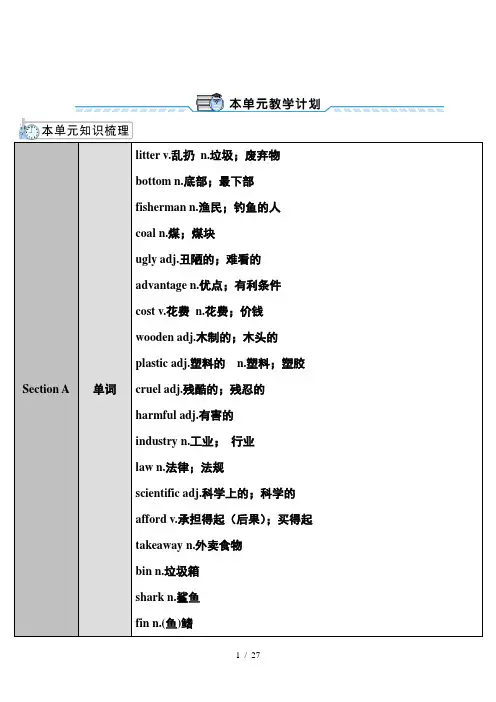
Section A 单词litter v.乱扔n.垃圾;废弃物bottom n.底部;最下部fisherman n.渔民;钓鱼的人coal n.煤;煤块ugly adj.丑陋的;难看的advantage n.优点;有利条件cost v.花费n.花费;价钱wooden adj.木制的;木头的plastic adj.塑料的n.塑料;塑胶cruel adj.残酷的;残忍的harmful adj.有害的industry n.工业;行业law n.法律;法规scientific adj.科学上的;科学的afford v.承担得起(后果);买得起takeaway n.外卖食物bin n.垃圾箱shark n.鲨鱼fin n.(鱼)鳍复习现在进行时、现在完成时和被动语态等的用法。
以“保护环境”为主题,运用本课相关句型与他人展开讨论;能向大家介绍有哪几种污染类型,怎样回收利用废弃物品等。
体会到保护环境的重要性,学会保护大自然、保护地球,从身边的小事做起,号召大家参与到保护环境的行动中来。
【课时建议】本单元建议5课时Section A (1a~2d)……………………………………………………………………………………1课时Section A (3a~4c)……………………………………………………………………………………1课时Section B (1a~1e)……………………………………………………………………………………1课时Section B (2a~2e)……………………………………………………………………………………1课时Section B (3a~3b)……………………………………………………………………………………1课时词汇短语:主要采用多媒体及图片展示法。
基本句子:采用图片展示及交际法(利用多媒体展示两人进行交际时的情景)。
语法:复习现在进行时、现在完成时和被动语态——采用“巧记歌诀”记忆法。
被动语态的用法谁的动作不知道,说出谁做没必要;承受之人需强调,被动语态莫忘了。
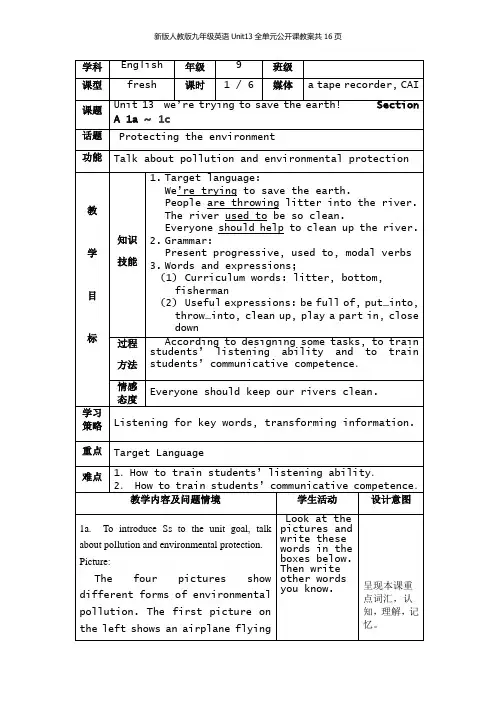
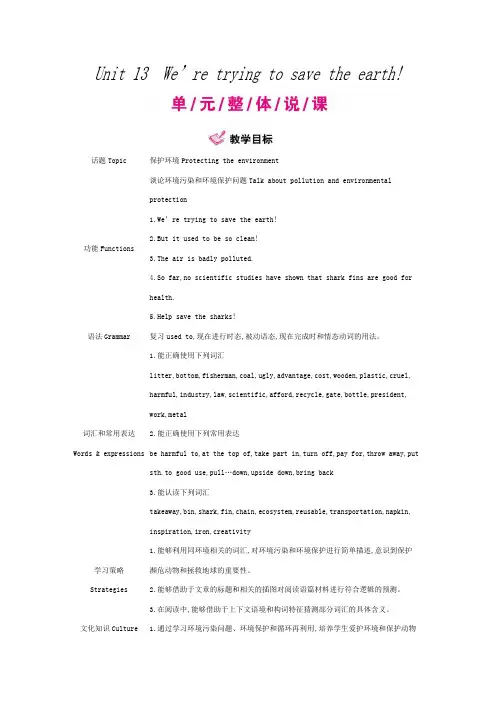
Unit 13 We’re trying to save the earth!话题Topic 保护环境Protecting the environment功能Functions谈论环境污染和环境保护问题Talk about pollution and environmentalprotection1.We’re trying to save the earth!2.But it used to be so clean!3.The air is badly polluted.4.So far,no scientific studies have shown that shark fins are good forhealth.5.Help save the sharks!语法Grammar 复习used to,现在进行时态,被动语态,现在完成时和情态动词的用法。
词汇和常用表达 Words & expressions 1.能正确使用下列词汇litter,bottom,fisherman,coal,ugly,advantage,cost,wooden,plastic,cruel,harmful,industry,law,scientific,afford,recycle,gate,bottle,president,work,metal2.能正确使用下列常用表达be harmful to,at the top of,take part in,turn off,pay for,throw away,putsth.to good use,pull …down,upside down,bring back3.能认读下列词汇takeaway,bin,shark,fin,chain,ecosystem,reusable,transportation,napkin,inspiration,iron,creativity学习策略Strategies 1.能够利用同环境相关的词汇,对环境污染和环境保护进行简单描述,意识到保护濒危动物和拯救地球的重要性。
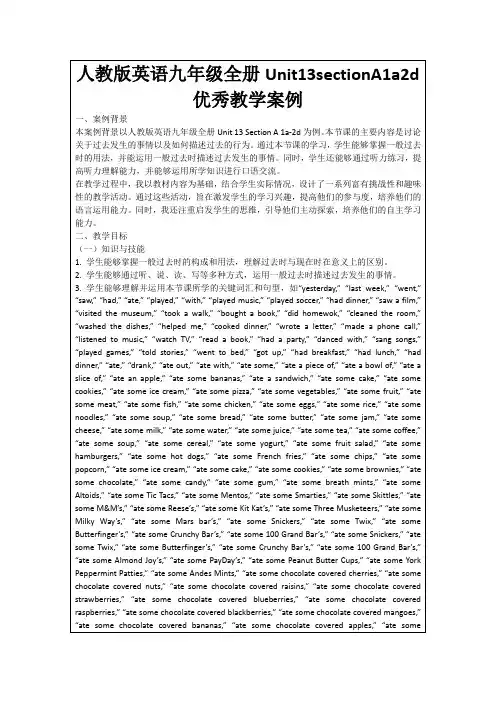
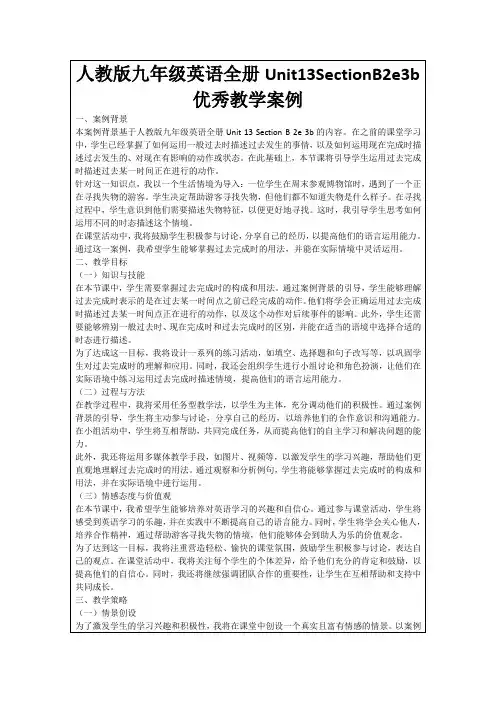
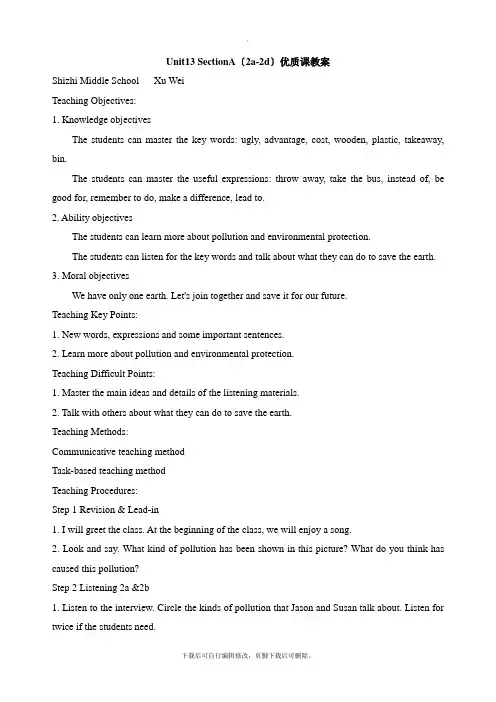
Unit13 SectionA〔2a-2d〕优质课教案Shizhi Middle School Xu WeiTeaching Objectives:1. Knowledge objectivesThe students can master the key words: ugly, advantage, cost, wooden, plastic, takeaway, bin.The students can master the useful expressions: throw away, take the bus, instead of, be good for, remember to do, make a difference, lead to.2. Ability objectivesThe students can learn more about pollution and environmental protection.The students can listen for the key words and talk about what they can do to save the earth.3. Moral objectivesWe have only one earth. Let's join together and save it for our future.Teaching Key Points:1. New words, expressions and some important sentences.2. Learn more about pollution and environmental protection.Teaching Difficult Points:1. Master the main ideas and details of the listening materials.2. Talk with others about what they can do to save the earth.Teaching Methods:Communicative teaching methodTask-based teaching methodTeaching Procedures:Step 1 Revision & Lead-in1. I will greet the class. At the beginning of the class, we will enjoy a song.2. Look and say. What kind of pollution has been shown in this picture? What do you think has caused this pollution?Step 2 Listening 2a &2b1. Listen to the interview. Circle the kinds of pollution that Jason and Susan talk about. Listen for twice if the students need.I will ask two students to share their answers with the class and check them.2. Listen again and complete the sentences. Listen for twice if the students need. I will ask one student to write their answers on the screen and check with the class.Step 3 Take a quiz1. Are you a friend of the earth? What do you usually do?2. Ask some students to choose what they usually do when they finish drinking a can of cola / when there are a lot of old newspapers at your home / when they go shopping / when they write on a piece of paper .Step 4 Watch and think1. Let’s watch a video. What you can see in it?2. Can we do something to save the earth?Step 5 Discussion1. What can you do to save the earth in our lives?2. What can you do to save the earth in our school?Step 6 Summary1. I will ask the students what are learned in this class.2. We will read the phrases on the screen together.Step 7 Homework1. Remember the new words and expressions.2. Write about what you can do to help save the earth in your life.Blackboard Design。
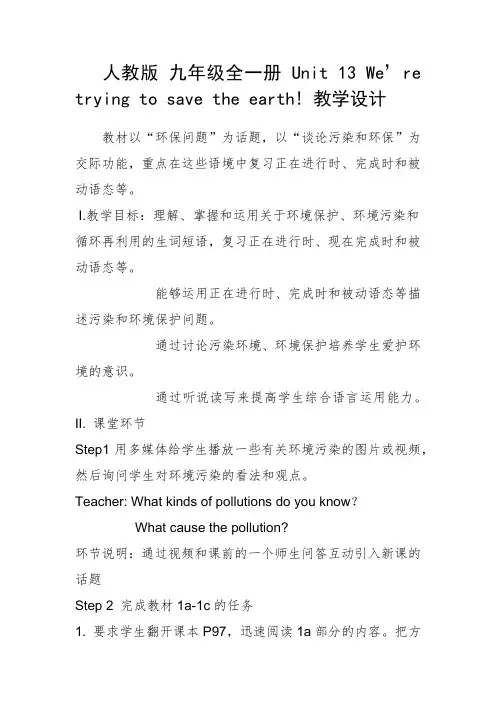
人教版九年级全一册 Unit 13 We’re trying to save the earth! 教学设计教材以“环保问题”为话题,以“谈论污染和环保”为交际功能,重点在这些语境中复习正在进行时、完成时和被动语态等。
I.教学目标:理解、掌握和运用关于环境保护、环境污染和循环再利用的生词短语,复习正在进行时、现在完成时和被动语态等。
能够运用正在进行时、完成时和被动语态等描述污染和环境保护问题。
通过讨论污染环境、环境保护培养学生爱护环境的意识。
通过听说读写来提高学生综合语言运用能力。
II. 课堂环节Step1用多媒体给学生播放一些有关环境污染的图片或视频,然后询问学生对环境污染的看法和观点。
Teacher: What kinds of pollutions do you know?What cause the pollution?环节说明:通过视频和课前的一个师生问答互动引入新课的话题Step 2 完成教材1a-1c的任务1. 要求学生翻开课本P97,迅速阅读1a部分的内容。
把方框中的单词按它们产生污染的类型写入相应的栏目中,并添加更多的单词。
2. 检查答案,先要求全班一起给出答案并检查讨论。
然后要求2-3名同学给出自己的答案,并把收集的答案列举在黑板上。
3. 要求学生听第一遍录音,并根据听到的内容完成课本上1b表格中的句子。
然后要求2-3名同学读答案。
(polluted, rubbish, fish Litter rubbish newspaper, stop, clean)4. 要求学生听第二遍录音,并逐句进行跟读。
5. 完成教材1c的任务,要求学生模仿1a内容,编造自己的关于污染的对话并进行对话练习。
并邀请2-3对同学当堂进行演示。
6. 小结训练。
要求学生在规定的时间内完成一个小练习。
并请若干学生给出自己的答案。
有错误的话及时解决纠正。
用所给词的适当形式填空。
1. There are many kinds of pollutions(pollute)in our daily life.2. All of the students should take part in keeping (keep) our school clean and tidy.3. Can you tell us your ideas for improving (improve) your spoken English.4. W e should stop using the wooden (wood) chopsticks toprotect the forest.5. Their grandparents were fishermen (fisherman) near the sea before they moved to the town.环节说明:通过学习1a,使学生对过去完成时态有所了解,并拓宽了思路;通过1b,锻炼学生的听力及抓取关键信息的能力;通过1c的训练锻炼学生的口头表达能力,同时巩固对本课内容的认识。
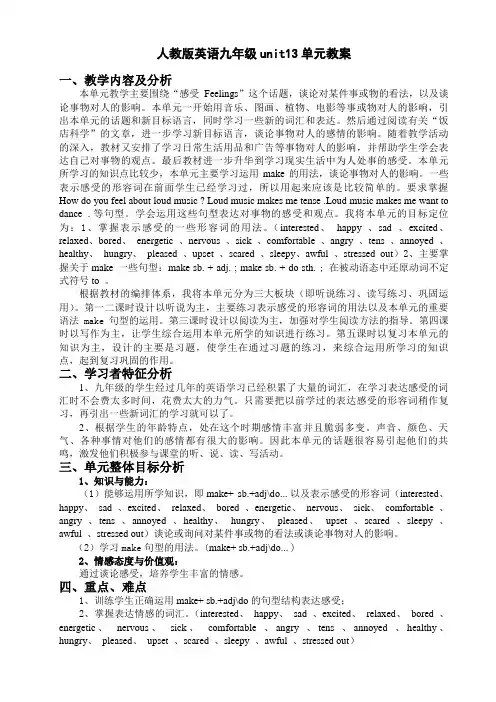
人教版英语九年级unit13单元教案一、教学内容及分析本单元教学主要围绕“感受Feelings”这个话题,谈论对某件事或物的看法,以及谈论事物对人的影响。
本单元一开始用音乐、图画、植物、电影等事或物对人的影响,引出本单元的话题和新目标语言,同时学习一些新的词汇和表达。
然后通过阅读有关“饭店科学”的文章,进一步学习新目标语言,谈论事物对人的感情的影响。
随着教学活动的深入,教材又安排了学习日常生活用品和广告等事物对人的影响,并帮助学生学会表达自己对事物的观点。
最后教材进一步升华到学习现实生活中为人处事的感受。
本单元所学习的知识点比较少,本单元主要学习运用make的用法,谈论事物对人的影响。
一些表示感受的形容词在前面学生已经学习过,所以用起来应该是比较简单的。
要求掌握How do you feel about loud music ? Loud music makes me tense .Loud music makes me want to dance .等句型。
学会运用这些句型表达对事物的感受和观点。
我将本单元的目标定位为:1、掌握表示感受的一些形容词的用法。
(interested、happy 、sad 、excited、relaxed、bored、energetic 、nervous 、sick 、comfortable 、angry 、tens 、annoyed 、healthy、hungry、pleased 、upset 、scared 、sleepy、awful 、stressed out)2、主要掌握关于make一些句型:make sb. + adj. ; make sb. + do sth. ; 在被动语态中还原动词不定式符号to 。
根据教材的编排体系,我将本单元分为三大板块(即听说练习、读写练习、巩固运用)。
第一二课时设计以听说为主,主要练习表示感受的形容词的用法以及本单元的重要语法make句型的运用。
Unit13 SectionA(Grammar Focus-4c)优质课教案一、教学分析1、教材分析本单元没有新的语法项目,主要是复习以前学过的语法项目。
Grammar Focus 的表格总结了本单元的典型例句,包括现在进行时、used to、被动语态、现在完成时态、情态动词的句子,而且每一个句子都是与环境污染或者环境保护话题有关。
4a提供了一段记者采访的对话,要求学生根据上下文填入动词的正确形式,学会区分不同的时态、不同语态的用法。
这个活动让学生在情境中、在交际中运用语法,从而掌握语法。
4b提供了一段保护环境从小事做起的篇章,让学生选择正确的情态动词填空,检测学生能否正确区别他们的意思和用法。
4a和4b的练习分别是对话和篇章的形式,但是话题都与环境有关,巩固语法的同时又是环境话题的输入。
4c则是开放性的输出活动,要求学生进行小组讨论,写下保护环境的方式,然后展示给全班,其他同学可以赞同也可以是反对这些做法,并对他人的想法表达意见。
2、学情分析九年级的学生已经具备了一定的听说读写能力,他们面临着中考,所以掌握更多的语言知识以及提高他们的听说读写的技能对他们尤其重要。
通过听说读写的训练,学生在关注认知语言结构的同时,还要关注语法内容的交际性运用。
学生对英语学习有较强烈的愿望和学习的兴趣,喜欢游戏、竞赛、小组合作等活动形式,课堂上教师应关注全体学生,尽量以鼓励表扬为主,营造学英语的氛围,鼓励学生开口说英语,写英语,让他们体味成功的喜悦。
二、目标的设定(1)知识与技能能够掌握单词、固定短语的应用;能模仿范例写句子;能正确朗读所学故事或短文。
(2)过程与方法能够掌握现在进行时、used to被动语态、现在完成时态、情态动词的用法,能够在交际中运用语法,从而掌握语法。
(3)情感态度通过本节课的学习,让学生有环境危机意识,学会关注环境保护环境。
(4)教学重点:能正确运用现在进行时,现在完成时,被动语态,情态动词和used to句型。
新版人教版九年级英语Unit13全单元公开课教案共16页ask them what they see。
Then。
ask them to predict what the article will be about based on the pictures.1b。
Play the recording and ask students to listen carefully for the target language and useful ns。
Have them take notes and then discuss their findings in pairs or small groups.1c。
Have students work in pairs or small groups to discussthe ns and prompts related to the article。
Encourage them to usethe target language and useful ns in their ns.The topic of this lesson is protecting the environment。
specifically focusing on n and environmental n。
The target language includes phrases such as "We're trying to save the earth" and "Everyone should help to clean up the river." The grammar covered includes present progressive。
used to。
and modal verbs。
nally。
students will learn new vocabulary words such as "litter," "bottom," and "fisherman."The teaching methods used in this lesson include listening for key words。
Unit13 Section A(3a-3b)一 Teaching aimsTarget language:No scientific studies have shown that shark fins are good for health.The number of some kinds of sharks have fallen be over 90 percent in the last 20 to 30 years.Grammar: Present perfectWords and expressions:Curriculum words: shark, cruel, harmful, chain, ecosystem, industry, law, scientific, afford, reusable, transportationUseful expressions: be harmful to, at the top of, the food chain, take part in, turn off, pay二Teaching key pointsTarget Language三Teaching difficult pointsHow to improve students’ integrating skills.四Teaching stepsStep1 Warming upStep2 Learning3a. To give Ss practice in reading for specific information. Learning more about sharksAsk Ss to do some additional research to find out more about sharks before this lesson.3b. To give Ss the opportunity to review the use of conjunctions. Shark fin soup is a Chinese delicacy that is popular not only in China, but also among the Chinese population in other countries like Singapore and Malaysia.Review of conjunctions○so: used to say that something is a result of something else that has just been mentioned.e.g. I was tired, so I decided to take a map.○ although: used to contrast one part of a sentence with another, has the effect of making the main idea in the sentence seem surprising or unexpected.e.g. Although she studied hard, she did not pass the exam.○ if: used to talk about the circumstances in which something else might happen; gives the condition for something else to happen.e.g. If you study hard, you will do well.○but: used to contrast two parts of a sentence and show that they are opposite or very different in meaning.e.g. The children stopped plying when they heard the bell.Step3 PracticeRetell the passage according to the words on the screenLanguage pointsStep4 Blackboard DesignUnit 13 we’re trying to save the earthSection A 3a -4cNo scientific studies have shown that shark fins are good for health.The number of some kinds of sharks have fallen be over 90 percent in the last 20 to 30 years.Step5 Teaching Feelings。
Unit13 SectionB(3a-3b)优质课教案老河口市仙人渡中学米星星Teaching contentsUnit13围绕“polluti on and environmental protection”为话题而展开活动。
Section B3a-3c活动以2b活动中废物回收利用的例子引出对环境保护的思考,引导学生开展环保写作。
3a为学生提供了语境,通过让学生思索讨论自己周围的环境污染问题,自然而然过渡到想办法保护环境上来,给学生提供了写作思路。
3c要求学生将写作落实到实处,给本市市长写封信提出一些建议,要求学生熟练运用本单元所学关于环保的各种短语和句型写出一片记叙文。
学生对环境的期望值越高就越有执笔写信的欲望,也将更用心表达自己的想法。
Teaching objects本课的教学对象是乡镇学校的普通班九年级的学生。
他们多来自农村家庭,英语学习意识薄弱,自主学习能力差,英语基础参差不齐。
很多学生对英语没有兴趣,觉得英语很难,听、说、读、写、译的技能都不高。
所以,在日常的教学过程中,教师多想办法,用贴近学生生活的话题做引导,调动他们的兴趣,鼓励他们大胆地用口语表达自己的想法,利用分析范文,小组合作讨论,集思广益,收集写作素材。
有助于学生用英语构思,形成合理的写作思路,在轻松快乐的氛围中把课本上所学的知识运用于口头表达和写作中。
引导学生养成良好的写作习惯,增强学生用英语写作的自信心,能学中乐,乐中学,逐步提高英语水平。
根据本课时在教材中的地位和作用,依据教学大纲,确定以下教学目标:Teaching aims1. 知识目标:在本节课结束时,学生能掌握句型:用should, could, suggest, be supposed to 表达建议;语法:被动语态,一般现在时和将来时的正确运用。
2. 能力目标:在本节课结束时,学生能够:(1) 用英语写出自己对目前环境的认识。
(2) 积极给予改善环境的可行性措施。